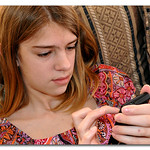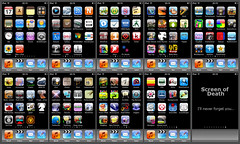 Why did Les Quennevais School, in Jersey, pilot a Bring Your Own Device programme, what challenges have emerged, and how do students use their devices?
Why did Les Quennevais School, in Jersey, pilot a Bring Your Own Device programme, what challenges have emerged, and how do students use their devices?
Responsible Use
 The general thrust of education these days is on student-centred learning. This is often expressed by depicting on the teacher’s role as being the guide on the side rather than the sage on the stage. Regardless of whether you agree that that’s how things should be (and as it happens I don’t: see Please! No More Mantras!), the often-stated philosophy these days is that students know best.
The general thrust of education these days is on student-centred learning. This is often expressed by depicting on the teacher’s role as being the guide on the side rather than the sage on the stage. Regardless of whether you agree that that’s how things should be (and as it happens I don’t: see Please! No More Mantras!), the often-stated philosophy these days is that students know best.
But does stating that philosophy mean that it is observed in practice?
BYOD Case Study: George Spencer Academy
 George Spencer Academy is a mixed secondary school in Nottingham, England, with 1350 students aged 11-18. Although it is located in a large town, it has only a small proportion of students who are eligible for free school meals.
George Spencer Academy is a mixed secondary school in Nottingham, England, with 1350 students aged 11-18. Although it is located in a large town, it has only a small proportion of students who are eligible for free school meals.
The school decided to go down the BYOD road in order to be able to explore the potential of personal devices without incurring costs of purchase, training or technical support. The idea also fits very well with the school’s vision, which is concerned with giving a personalised learning experience to all students.
Recommended reading
 Here is a selection of online articles that I think worth reading – some of them are my own (he says modestly), but others are others’! They cover a wide range of topics, including the flipped classroom, Bring Your Own Technology, what happens in an internet minute, up and coming conferences and others.
Here is a selection of online articles that I think worth reading – some of them are my own (he says modestly), but others are others’! They cover a wide range of topics, including the flipped classroom, Bring Your Own Technology, what happens in an internet minute, up and coming conferences and others.
BYOD Case Study: Finborough School
 Here is an interesting case study of how a small school has successfully introduced BYOD with a particular group of pupils.
Here is an interesting case study of how a small school has successfully introduced BYOD with a particular group of pupils.
Finborough School is an independent, ie private, all-through school, ie age range 2-18, in a rural English setting. It has 274 pupils.
Mobile Learning Case Study: Copland Community School
Mini-review of the Motivating Educators, Inspiring Learners Conference
 “Well”, said Elaine as I bounced in last Wednesday evening. “You’ve got your mojo back.” This was quite true. Having spent a few hours reading various articles about why things can’t be done, or how there could be dire consequences if they were, I wasn’t in much of a frame of mind to attend a conference, especially one which seemed to be ‘motivational’. Quite frankly, when I’m feeling miserable the last thing I want is someone trying to cheer me up.
“Well”, said Elaine as I bounced in last Wednesday evening. “You’ve got your mojo back.” This was quite true. Having spent a few hours reading various articles about why things can’t be done, or how there could be dire consequences if they were, I wasn’t in much of a frame of mind to attend a conference, especially one which seemed to be ‘motivational’. Quite frankly, when I’m feeling miserable the last thing I want is someone trying to cheer me up.
BYOD Case Study: Archbishop Lanfranc School
 The school is moving towards a totally cloud-based system using mostly mobile technology. Therefore BYOD will become another facet of this by allowing students to use mobiles when appropriate, in addition to the kit provided by the school.
The school is moving towards a totally cloud-based system using mostly mobile technology. Therefore BYOD will become another facet of this by allowing students to use mobiles when appropriate, in addition to the kit provided by the school.BYOD: What’s in a name?
 When I started to look at the whole Bring our Own Device phenomenon, I thought it was all pretty simple. Mal Lee and EdFutures have drawn a distinction between BYOD (Bring Your Own Device) and BYOT (Bring our Own Technology). These are helpful, but unfortunately things ain’t that simple.
When I started to look at the whole Bring our Own Device phenomenon, I thought it was all pretty simple. Mal Lee and EdFutures have drawn a distinction between BYOD (Bring Your Own Device) and BYOT (Bring our Own Technology). These are helpful, but unfortunately things ain’t that simple.
What are the features of a good ICT activity?
 I was invited to give a talk recently, and one of the questions I was asked to address was: what are the characteristics of a good ICT activity? This is one of the questions which, at first glance, seems really easy to answer – until you get down to thinking about it. Because what the question is really asking, I think, is what makes a good ICT activity good in a unique way: that is, unique to ICT.
I was invited to give a talk recently, and one of the questions I was asked to address was: what are the characteristics of a good ICT activity? This is one of the questions which, at first glance, seems really easy to answer – until you get down to thinking about it. Because what the question is really asking, I think, is what makes a good ICT activity good in a unique way: that is, unique to ICT.
BYOT Case Study: Scargill Junior School
 Describing itself as being on the ‘networked’ stage of the continuum, Scargill school’s current Bring Your Own Technology model consists of utilising a wide range of mobile devices in school in order to enhance and support the learning in the classroom. It started with Nintendos approximately 6 years ago. But what prompted Scargill to consider a BYOT approach in the first place?
Describing itself as being on the ‘networked’ stage of the continuum, Scargill school’s current Bring Your Own Technology model consists of utilising a wide range of mobile devices in school in order to enhance and support the learning in the classroom. It started with Nintendos approximately 6 years ago. But what prompted Scargill to consider a BYOT approach in the first place?BYOT: the policy that dare not speak its name?
 A couple of months ago Mike Sharples, a researcher at the Open University, told me that he had looked at the websites of some of the schools I was writing up case studies on in connection with their Bring Your Own Technology policy, but was unable to find any references to it whatsoever. He came to the conclusion that:
A couple of months ago Mike Sharples, a researcher at the Open University, told me that he had looked at the websites of some of the schools I was writing up case studies on in connection with their Bring Your Own Technology policy, but was unable to find any references to it whatsoever. He came to the conclusion that:
BYOT is the policy that dare not speak its name.
I have to say that although there are quite a few schools adopting a BYOT approach, finding them has not been easy.
Bring your own thinking
 A few years ago I said to one of my team, having been in the new management post for about a week, “How come nobody here ever takes a decision? How come they always ask me what they should do, especially when they know more about their specialist area than I do?”
A few years ago I said to one of my team, having been in the new management post for about a week, “How come nobody here ever takes a decision? How come they always ask me what they should do, especially when they know more about their specialist area than I do?”
“Because”, came the reply, “Our last boss always had an opinion on everything, and stuck to it whatever anyone else suggested. So we very soon learnt that there was no point in doing any of the thinking for ourselves.”
Mobile phones in education revisited
![]() The most popular article on the ICT in Education website is one by a 17 year-old student called The Importance Of Mobile Phones In Education. To give you an idea of its popularity, I would estimate that it has been viewed at least 30,000 times since it was published back in July 2010. So the question is, why is it so popular?
The most popular article on the ICT in Education website is one by a 17 year-old student called The Importance Of Mobile Phones In Education. To give you an idea of its popularity, I would estimate that it has been viewed at least 30,000 times since it was published back in July 2010. So the question is, why is it so popular?
Is it because it was written by a student? Well, there is no doubt that student articles receive a lot of attention, but not usually this much.
Is it because it is about mobile phones? I don’t think so: I have written about mobile phones before, and again, the articles haven’t attracted 30,000 views as far as I know.
I think the answer lies in the combination: an article about mobile phones written by a student who appears to be surgically attached to one.
Bring your own technology
 If ever there was an idea whose time has come, it is surely Bring Your Own Device or, to be less restrictive, Bring Your Own Technology. There are at least two comp0elling reasons for this.
If ever there was an idea whose time has come, it is surely Bring Your Own Device or, to be less restrictive, Bring Your Own Technology. There are at least two comp0elling reasons for this.

